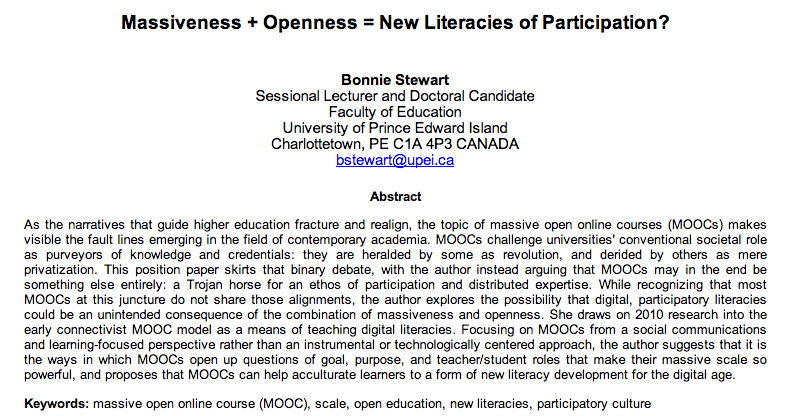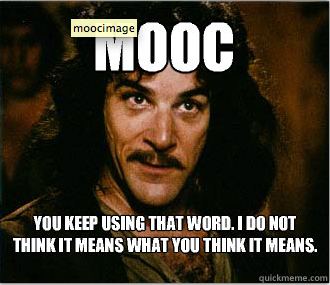Today, class, we’re going to talk about networks. And education. And power relations. Yes, again. I KNOW. You poor lambs.
I fear becoming a proselytizer. The good people who show up at my door asking if I know Jesus are not my people. I like doubters, complications, ideas that break down assumptions and build toward further questions, not answers.
And yet every time I introduce the topic of networks I feel as if I inch a little closer to preaching to the self-selected network choir and ONLY the network choir and I worry. Preaching is not the work I set out to do. Rather, I want to dig, to lay out ideas, to build new ideas. I am ever-tempted by the Tree of Knowledge. But – and this is my problem, perhaps, a problem shared by my entire household…or at least its members over four feet tall – I no longer think it is a tree.
I have thought, for ten years since I first read Deleuze and Guattari and mentioned them in passing to Dave Cormier in a long-distance phone booth call from Switzerland to Korea, that it is a rhizome. The fruit of the Tree of Knowledge is not an apple, in my belief systems.
It is a weed.
Yet I was raised by the tidy gardeners and the pesticide companies and the folks who built enclosures for weedy ideas, locking them in like dandelions under glass. And likely, dear reader, so were you.
I talk about networks not to try to convert you…but to try to understand the limits of the systems we were raised in. To understand what is happening now that structure of those systems and their institutions no longer describes the structure of information flow in our society. To understand how and why the powers-that-be still rely, structurally, on those systems’ totalizing capacity. To ask how it has come to be that participatory networked practices are more likely to be framed as threats than opportunities for education in the 21st century. And to wonder who benefits from that framing.
(Okay, maybe I am trying to convert you, a little. Only because the Eden we thought we grew up in is gone.)
***
I chose a profession I initially understood in terms of tidy gardener and encloser roles: I became a teacher. I wanted to get as close to the Tree of Knowledge as I could, and to bring others into that garden. But teaching is messy: it bears little resemblance to distributing apples in Eden. I taught Inuit high school students from a social studies curriculum in which their people and their history did not appear at all; I taught GED adult learners in a back room in a tiny rural schoolhouse where many of them had learned, as children, that they were not made to succeed in school. The desks were too small for all of us. The metaphorical apples clunked on the floor. My students had long ago learned to distrust apples.
It was through weeds that I reached them, any of them, to whatever extent I reached them: informal threads snaking from one human to another. They were not Eves waiting to eat. Our learning happened underground, snaking underneath the formal level of the curriculum. Tentative connections, in multiple directions. I tried to design learning experiences, but I did not control them. Most often it was me who learned: variations on How Not To Fail The Same Way Twice.
I began to understand that my concepts of success and failure were stacked around a very narrow stream of life options and legitimacy. I began to sense the edges of what Knobel & Lankshear (2006) call “the deep grammar of schooling,” the institutionalization of my own thoughts and conceptual tools. I began to think of print as an educational problem for my students, not a solution.
My issue was not with the technology of letters per se. I love print as text, the ways its technology of letters allows for skimming and floating and starting in the middle.
My critique was for the culture of print: the Truths we use it to reinforce and regulate and reify.
My Masters thesis (2000) led me to think about the ways print works, about the ways in which the technologies of a given time shape what it means to know in that time. Things written in print are either finished or not. They do not blend into each other; they do not create webs. They create canons, privileging some over others and erasing the steps of their logic so as to make it all appear natural. They encourage us to see knowledge as finite and discrete; truth as singular, sanctioned. Our cultural attachment to the idea of knowledge as arboreal, tree-like, apple-whole: this is based in print, in The Good Book itself and moreso, in the very idea of The Good Book. Yet this Eden of high print culture, so deeply embedded in Enlightenment ideals of binaries and taxonomies, has never really had apples for everybody.
Dave Cormier’s #rhizo14 course this week is taking on the limitations of print in a Nicholas Carr parody titled “Is books making us stupid?” Risky, that. Even those of us who have spent years unpacking all the ways that print as a medium hardens and solidifies knowledge are still culturally conditioned to love books. *I* love books. When Dave announced the title for this week’s theme, I laughed and winced and hoped no offended book enthusiasts would feel it necessary to beat him about the head with a dictionary.
I don’t think books make us any stupider currently than we always have been. But even as we cling to our bookshelves of beloved companions with their dusty pages and their old-book smell, it behooves us to consider the ways in which print has shaped us societally towards institutionalization and compliance, the ways in which the deep grammar of schooling is written in print.
Because we are conditioned think of books not as technologies of paper, with particular affordances, but as representations of human good.
It’s true that until the last generation, books stood as the epitome of human capacity to share knowledge. Books were bastions against ignorance…symbols of freedom of thought against repression and enclosure. But…and this is important…it was the free exchange of ideas and communications we valorized in that Enlightenment ideal. Not actually the small yet increasingly commodified paper packet. Yet we conflated the two. And in the process, we allowed the grammar of schooling to reinforce a Romantic identification of books, in particular, with all things noble about humanity.
And that’s a mistake, because for all that good and that beautiful, undeniable history, books and their affordances – their action possibilities – are part of a complex economic system just as digital technologies are, and create mindsets that can be as limiting as they are freeing.
Books teach us implicitly that the culmination of writing as an act of communications is a product, not a conversation; a finite rather than a fluid thing. Books teach us that the one speaks to the many, but the many cannot speak back and be heard.
Education as a system is built upon and relies on the taxonomic, hierarchic structures print reinforces. It relies on people learning their places within those structures. Education is historically both a product and a producer of a deeply-embedded command and control society, as Matt Reed pointed out in Inside Higher Ed earlier this week. Now, networks have power relations too…networks can amplify inequality just as they amplify everything else. But their power relations are less fixed, more quixotic. They can cause harm, absolutely. But our conversations about that harm and about throwing one’s life away with a tweet seldom take up the harm that institutionalized power relations of racism, sexism, heterosexism, ableism, and classism enact upon people every day. Those are the power relations naturalized by The Book and the deep grammar of schooling it is embedded in.
And here’s the thing. Perhaps that was, arguably, the best we could do. At least until knowledge and information exceeded the scarce and weighty bonds of paper and the distribution structures of shipping through time and space. It is no longer the best we can do. It is no longer WHAT most of us do, in our day to day lives. Yet the institutions and gatekeepers of the old Eden struggle to adapt and maintain the familiar balance of power by convincing us we are still better off relying, passive and trusting, on their noblesse oblige than on each other.
I do not think we should throw out our books. I am not such a network evangelist that I want what books have stood for to fall away from us, as humans. But nor do I want that to remain the limit of our vision.
Because in a world of information abundance, the walled Garden of Eden it reified is…gone. It cannot be brought back. Those who sell us a simulacra of its glories are only propping up the power relations of the past.
That Eden of *real* print culture is only a Potemkin village now, no matter how the gardeners and the pesticide companies would like to gain control back over the weeds. Let us leave the apples behind, and see what those weeds can reap.


